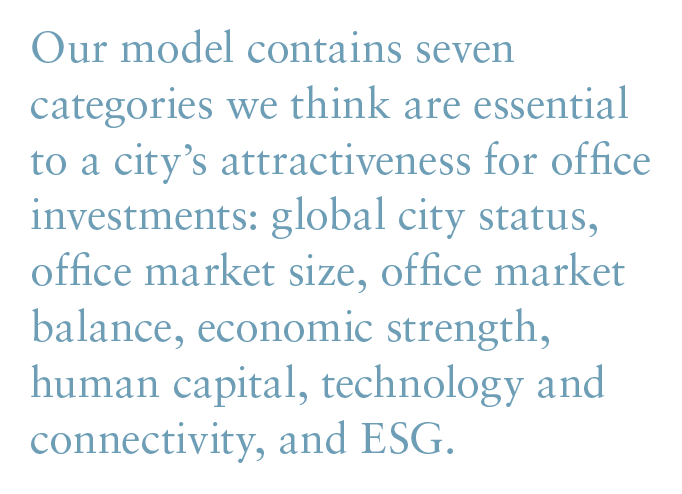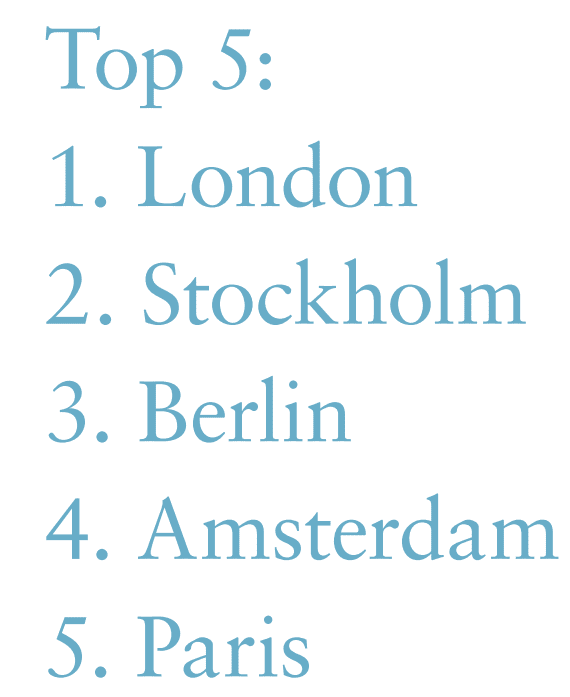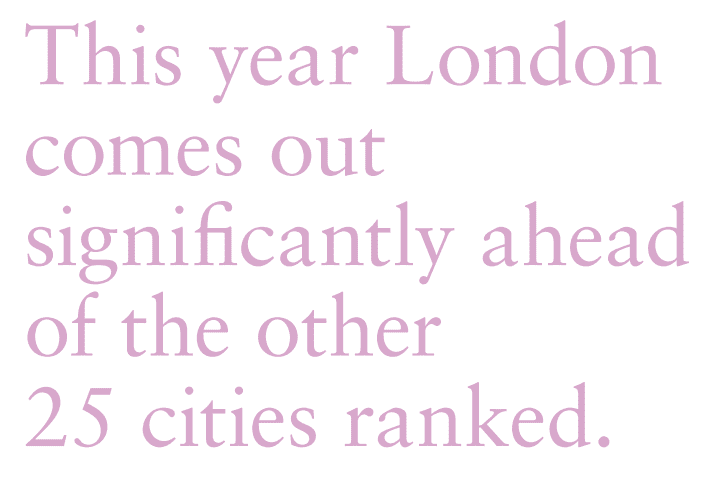Allianz Real Estate’s “Cities That Work” study applies a current office sector outlook to understand what makes London, Stockholm, Berlin, Amsterdam, and Paris the top cities for office investment.
The world and the way we work has radically changed over the last year. Working from home has gone from a niche practice to a key part of many firms’ future strategies; however, offices will likely remain crucial for collaboration, training, and maintaining corporate culture. Changing practices will fuel continuing bifurcation between prime and secondary offices, and the location and quality of assets will be more important than ever. The pandemic has also accelerated existing structural trends, in particular the rise of the tech sector.
To compile this study, we have made significant methodology changes to reflect this new environment.* Growing internal and external ESG awareness is represented in a new category with distinct environmental, social, and governance components.
In addition, our tech and connectivity category has increased in sophistication and is weighted much heavier. Highly unusual market conditions mean we can only provide structural scorings; the lack of liquidity in most markets has made many of the short-term indicators used previously within the tactical scorings unreliable or even misleading. All these changes have resulted in considerably different rankings for many of the cities scored.
WHAT MAKES A CITY ATTRACTIVE?
Our model contains seven categories we think are essential to a city’s attractiveness for office investments: global city status, office market size, office market balance, economic strength, human capital, technology and connectivity, and ESG.
Office market size, office market balance, and economic strength
A healthy local economy and office market are important to all real estate investors. Long-term investors would typically target core offices with a strong preference for large markets with a good stock of modern assets.
Solid forecasted rental growth is important for maintaining capital values and income streams; this is balanced with low market volatility, which helps to limit downside risks. Population density is increasingly important; in dense cities workers are more likely to rely upon external office space. Finally, the value of offices is strongly correlated with local GDP and growth in the service sector.
Global city status
Alongside these traditional real estate factors, we believe a city’s global prominence will strongly influence its future success. A city with a solid globally recognized brand will be able to attract international corporations, workers, students, and capital. As talent and business arrives, they are integrated into a network that is difficult to leave.
The stronger the city’s brand, the stronger the network and cultural offering and thus higher incentive for more participants to join. A city’s ranking in this category was the best predictor of its overall ranking.
Human capital
The quality of human capital available in a city underpins its long-term prospects. Competition for high-quality labor has increased: the reservation wage—the minimum wage a worker would accept to take on a new job—spiked in 2021 in many countries. The size and quality of local universities will affect the supply of young and educated talent that firms require.
On average, a third of graduates will live and work in the city they studied in, rising to two thirds in the most globally prominent cities. At all levels, widespread acceptance of working from home gives workers more options for where they want to live. As a result, high quality of life is more important than ever for attracting and retaining talent.
Technology and connectivity

The tech sector has grown faster than any other in recent years, and there are good reasons to believe the pandemic will only further strengthen small and big players.
Global venture capital funding in the first half of 2021 shattered records at US$288 billion—US$110 billion higher than the previous record. Tech firms now make up nine of the ten most valuable companies globally, with many drastically increasing in value over the course of the pandemic. Traditional office occupiers face an existential threat; JP Morgan’s last annual shareholder letter discusses the “enormous threat” of competition from tech competitors.1
High quality transport infrastructure has also increased in importance as a result of environmental concerns and the availability of an alternative to commuting.
ESG
ESG factors are now widely accepted internally and externally as a part of the investment process. The importance of environmental concerns is well understood as countries commit to more stringent green targets and markets price in measures like carbon taxes. However, awareness of social and governance factors is lower, particularly in real estate.
Our model incorporates a social cohesion metric that includes city-level inequality, crime rates and happiness; low scores may leave a city vulnerable to brain drain. Also included is a governance score incorporating city-level corruption, strength of legal rights and political stability; good scores should indicate both lower reputational risks and volatility of future prospects.
LONDON 🇬🇧
This year London comes out significantly ahead of the other 25 cities ranked, with excellent scores in every category. (See also: AFIRE 2022 International Investor Survey)
England’s capital is ranked first for global city status: it is consistently ranked as one of the top three global cities and often ranked as the world’s most important. Its network of six major airports makes up the world’s busiest air transport system. This prominence has enabled it to be a truly international hub with more than 37% of the population born outside of the UK.
London is also ranked first for human capital: a growing population and more than 400,000 students at more than 43 institutions mean it has an excellent labor supply. The size of London’s universities is matched by their quality: four are ranked in the Times Higher Education top 100, a number only equaled by Los Angeles. Although London’s population growth is not massive it still is the sixth highest of the cities scored.
The rise of the tech sector will disproportionally benefit London, which is Europe’s most important tech hub. The city receives far more in venture capital funding than anywhere else in Europe: around EUR 16 billion in 2020, four times its next rival Paris. In recent years, tech hubs such as “silicon roundabout” and King’s Cross have emerged around some of the key central universities. London also benefits from an expansive network of public transport including the world’s fourth largest subway system.
Alongside these structural strengths, London’s office market is one of the most important globally. In Europe, by transaction volume over the last five years, London is second only to Paris, and is nearly three times larger than third-largest Frankfurt. International investors hungry for trophy assets and stable income have a strong preference for London; the city has often received more foreign capital than any other city globally. The UK’s economy is starting to move on from the twin crises of Brexit and COVID-19, and so is expected to grow exceptionally well in the short to medium term. This strength alongside predicted falls in vacancy rates help London achieve the highest forecasted rental growth in Europe.
STOCKHOLM 🇸🇪
Although Stockholm is unexceptional in terms of global city status and real estate market size, it earns second overall ranking through top scores in all other categories.
Stockholm’s biggest strength is its office market balance with a top ranking. Low volatility has resulted in significantly above average risk-adjusted returns over the last fifteen years. Stockholm also has the second highest rental growth: despite presently challenging conditions, falling vacancy and growth in key sectors should lead to excellent growth in the medium term. The long-term prospects for the office market are aided by above average population density.
The economy of Stockholm is very robust, with some of the highest rankings for both overall GDP growth and service sector growth. Since the 1990s, Stockholm’s tech industry has been a continual source of growth, with three times as many people employed now in IT and communications as the EU average. The sector is supported by a healthy start-up scene that has produced notable successes including Spotify and Klarna.
Alongside all four Nordic cities scored in this report, Stockholm receives a top ESG ranking. The city was awarded Europe’s first European Green Capital in 2010 and aims to be fossil fuel free by 2040. Furthermore, 99% of solid waste is recycled and 50% of Sweden’s electricity comes from renewable sources. Alongside environmental strengths the city does well on governance and social cohesion. Sweden’s legal rights are ranked as the fourth strongest in the world, only beaten out by three other Nordic countries. In addition, Stockholm is ranked as the ninth happiest city in the world by the World Happiness Index.
BERLIN 🇩🇪
The most globally connected city in Germany has used its accessibility to attract international talent and cultivate a growing tech sector.
Berlin’s rich history, world class cultural offerings and open values have helped it gain third place for global city status. The relatively low cost of living makes Berlin much more affordable than many other global cities. The city is the most multicultural in Germany with more than 800,000 of the 3.7 million residents possessing a foreign passport. Furthermore, Berlin has profited from steadily increasing tourism and the continuing relocation of government ministries from other parts of Germany.
The city’s aforementioned accessibility helps it receive a third place ranking for tech and connectivity. Global outreach and solid universities have helped fuel a booming startup scene that has produced eight tech unicorns. Access to global talent has been crucial to this growth as almost 30% of start-up staff are from abroad. Berlin’s transport infrastructure is also excellent: research has shown the city’s public transportation system is the fastest in the world, alongside Paris.
Berlin’s office market receives consistently good scorings that allow it to take 3rd place for market balance. Despite an uptick in 2020, Berlin’s office vacancy rate remains one of the lowest in Europe, due in part to the city being also almost twice as dense as other major German cities. Forecasted rental growth and risk-adjusted returns are both above average. A potential risk is that the floorspace per worker is higher than cities like London and Paris, and so working from home may impact the local market more.
AMSTERDAM 🇳🇱
The forward-thinking capital of the Netherlands has unexpectedly benefitted more than any other city from the fallout of Brexit.
Amsterdam’s office market’s attractive qualities allow it to take second for office market balance. Risk-adjusted returns over the last fifteen years are more than double the average of the cities scored. Local office vacancy is at its lowest since the early 2000s and is now below the European average. Unlike many other markets, rental values did not fall in 2020, albeit with increased incentives. This strength is expected to continue; Amsterdam is expected to grow at the same high rate as Stockholm in the future.
Like most of the highest scoring cities, Amsterdam receives a top five scoring for global city status. Dutch regulation and a more than 90% English-speaking population help make the city an attractive hub for international business. As a result, Amsterdam made significant gains in the wake of Brexit, as shown by the city briefly recording a higher trading volume than any other European financial center. The city also benefits from extensive tourism with more than 5.3 million international visitors and 16 million day trippers visiting the city every year.
The city’s forward-thinking approach helps it get good scores in technology & connectivity, human capital and ESG. Alongside London, the city has developed into a key green finance hub and is ranked 1st on the Green Finance Index. The cities vibrant start-up scene has produced two of the most valuable tech companies in Europe: Adyen and Takeaway.com. Amsterdam is also renowned for its urban planning, with excellent walkability, green spaces and bike access—by some estimates the city has more bikes than people.
PARIS 🇫🇷
The largest office market in Europe has a world-class startup ecosystem, but is held back from the very top of our scorings by weak ESG scores.
The strength of Paris’s startup scene and high patent applications secure it the top ranking for technology & connectivity. In and around east Paris’s thirteenth arrondissement are several of the world‘s best start-up incubators, including Station F, the world’s largest. The French government wants to capitalize on this advantage with president Macron recently stating a goal of ten tech companies worth EUR 100 billion by 2030. Paris’s already extensive metro system will more than double in size when the Grand Paris project completes towards 2030.
The only other city in Europe that approaches London’s global prominence, Paris wins second for global city status. Paris is the largest of the cities scored by population and by metro economy—the fifth largest in the world. For centuries, the city has been renowned as a cultural hub for its high gastronomy, art, and literature. This status is part of why it is has the second most international visitors of any city globally, falling behind only Bangkok.
As the finance and business center of France, Paris remains a key European office market. By transactions from 2016 to 2020, Paris is the largest market in Europe with EUR 20 billion of transactions over the period. Limited availability of space has resulted in relatively smaller pipeline than most of the cities scored.
CITIES TO WATCH

Copenhagen 🇩🇰
Copenhagen’s growing service and export-oriented economy helps bring it into the top ten with the 5th highest forecasted GDP growth. This economic strength is supported by population growth: the city is one of only three scored with forecasted population growth above 1% a year.
Like the other three Nordic cities scored it also has strong forecasted service sector growth and a top six ESG ranking. However, the limited size of its office market and past volatility keep it out of top five.
Frankfurt 🇩🇪
Germany’s premier business and finance hub contains the Frankfurt Stock Exchange, the headquarters of the European Central Bank, Deutsche Bank and DZ Bank amongst others. Frankfurt is Germany’s largest office market by transactions and the third largest of the cities scored.
Frankfurt’s office market is particularly attractive: it has the fifth smallest relative incoming supply, third highest risk-adjusted returns, and above average forecasted rental growth.
Barcelona 🇪🇸
Barcelona punches above its weight in global city status, helped by its position as an important European transport hub and far-reaching cultural exports. The city is the fourth most visited in Europe and has the busiest European passenger seaport.
The city also has a fast-growing tech ecosystem fueling the 4th highest service sector growth of the cities scored. Relatively low labor costs make Barcelona a natural location for international firms‘ development centers, including Nestle and Asics.
Brussels 🇧🇪
Sitting right in the middle of the pack Brussels receives generally good scores, but is held back by limited past and forecasted rental growth.
The heavy presence of EU institutions has been a major source of resilience during the pandemic. Government lettings in Brussels are extremely secure and had some of the highest rents agreed in 2020. The EU is planning to give back some office space by 2030 but not in assets in the city center.
Prague 🇨🇿
The low overall ranking Prague receives masks some notable strengths: excellent ESG scores in all categories, fourth highest economic growth and well-regarded universities.
It could be argued that Prague is the most well-rounded target for investors interested in Eastern Europe. By some measures, Prague is more developed than Budapest, and its office market does not have the oversupply issues seen in Warsaw.
—
ABOUT THE AUTHORS
Megan Walters is Global Head of Research for Allianz Real Estate. Additional contributors for this research include Gizem Bartu, Dr. Clemens Ernst, and Luke Latham.
—
NOTES
* The Allianz Real Estate Office City Index is a proprietary ranking of European cities for office investments. From this ranking of European cities with a population greater than 500,000, a shortlist of 26 cities has been created based on a number of screening criteria. The index was compiled using data across seven dimensions, incorporating twenty proprietary and external indicators, which were used to generate structural scores for each city.
1JP Morgan Chase & Company, “Annual Report 2020,” JP Morgan Chase & Company, updated April 7, 2020, reports.jpmorganchase.com/investor-relations/2020/ar-ceoletters.htm#banks-enormous, accessed April 29, 2022.
EXPLORE THE FULL ISSUE (SPRING 2022)

MARCHING BACKWARDS INTO THE FUTURE
The new 2022 AFIRE International Investor Survey Report reveals future institutional investment trends as the pandemic transformed how we live, work, and play.
Gunnar Branson and Benjamin van Loon | AFIRE
CITIES THAT WORK
What is it that makes London, Stockholm, Berlin, Amsterdam, and Paris the top European cities for office investment? And what could this mean for other global cities?
Dr. Megan Walters | Allianz Real Estate
SURVEY SURFEIT
Be careful about advice you hear from surveys— it will not always play out as expected.
Jim Costello | MSCI Real Estate
NEW WORKING AGE
Outside of WWI and II, the US working age population has never declined. As of 2021, that statement is no longer true.
Stewart Rubin and Dakota Firenze | New York Life Real Estate Investors
SELECTIVE FRAMEWORK
Two years after offices closed due to the COVID pandemic, the debate over the longterm future of the office continues. What should office investment look like going forward?
Dags Chen, CFA; Ryan Ma, CFA; and Ryan LaRue | Barings Real Estate
GARDEN VIEW
US garden apartment investments are offering outsized return potential –but access remains a challenge.
Martha Peyton, PhD | Aegon Asset Management
SINGLE-FAMILY DEMAND
As an increasingly popular asset class for institutional investors, single-family rentals are supported by strong future demand drivers to propel sector outperformance.
Daniel Manware | Nuveen Real Estate
ESSENTIAL HOUSING
The US is in the middle of one of the biggest housing crises that the country has ever seen. It needs a more resilient approach to housing.
Todd Williams | Grubb Properties
LODGING TAKES THE LEAD
As a labor-intensive and service oriented asset class, hospitality is uniquely positioned to be a leader in advancing sustainability goals for investors.
Charlotte Kang, Geraldine Guichardo, Lori Mabardi, and Emily Chadwick | JLL
CARRY ON, CARRY OVER
While continuation vehicles were once viewed as a signal of delay or failure, market sentiment is rapidly changing.
Max LaVictoire and Ashley Anderson | Hodes Weill & Associates
RENEWING ETHICS
A note from AFIRE’s Ethics Chair on the need for maximizing ethics in an age where globalization is under threat.
El Rosenheim | Profimex




